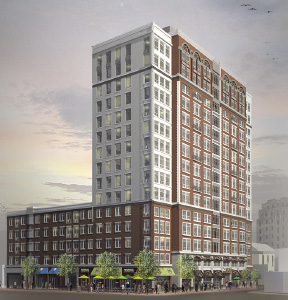With a variety of new residential and commercial construction projects, improved transportation networks, numerous public sector improvements and strengthening partnerships, the city of Quincy, Massachusetts is on the move and will continue its transformation in 2013.
After over eight years of planning, a shovel will go in the ground in the coming weeks to begin the private sector portion of the long awaited $1.6 billion redevelopment of historic downtown Quincy. Spearheaded by the partnership of Beal/Street-Works, the transformation of our urban city is the largest development in the Commonwealth of Massachusetts and will continue for the next seven years.
Phase 1 construction of Merchants Row at the 1400 Hancock St. block will entail new street level retail, restaurants, great new sidewalks, and approximately 300 residential units on the upper floors focused around a new public place known as the Kilroy Courtyard. In addition, a new street - to be known as Kilroy Way - is being introduced to reduce the scale of the large block. Similar in scale and character to the great alleys of Beacon Hill in Boston, Kilroy Way will provide a through-block connection between Chestnut St. and Hancock St. and will create pedestrian access to more street level shops as well as to the new 200 space, below grade public parking garage.
The residential units will include the Granite Trust Lofts, a new 5-story building whose architectural style and detail, color, street level storefront and materials have all been designed to reflect an Art Deco orientation and to match 1400 Hancock's existing materials and aesthetic.
Around the corner, on Chestnut St., The Kilroy is a 15-story building with residential rental units above the street level restaurants and shops.
The design of both new buildings will establish a sense of continuity with neighboring buildings while introducing imaginative and high quality design of this generation. The target audience for these new residences are under 35 young working professionals and the now aging baby boomer generation who are looking for a vibrant urban lifestyle at affordable rents.
In unison with the start of Merchants Row the city is working with Boston-based Halvorson Design Partnership and MassDOT to finalize designs for Adams Green, the open space lynchpin for Downtown Quincy's sweeping redevelopment, which will begin construction in the later part of 2013.
Adams Green will be located between the entrance to the Quincy Center Red Line/Commuter Rail station, Old and New City Halls and the point at which Hancock St. curves into Washington St. The former surface of Hancock St. will be replaced by two adjacent straight pedestrian paths, separated by a series of grassy rectangles. This "promenade" corridor will be lined with trees, flowering plants and benches, and will provide safe and convenient access to three of the city's most important historic sites: United First Parish Church (burial place of Presidents John Adams and John Quincy Adams and their wives, Abigail and Louisa), Old City Hall and historic Hancock Cemetery.
The city of Quincy is welcoming economic investment and public sector improvements in all corners of the community. Several additional private sector projects underway in 2013 include the construction of a $30 million, 118,000 s/f South Shore YMCA; a $30 million new 141-bed, 57,000 s/f. South Cove Manor Nursing and Rehabilitation Center; and a 180 unit residential/commercial building across from the Quincy Adams MBTA Red Line Station. Public sector projects by the city include a $50 million new Central Middle School, and a $20 million renovation of Old City Hall along with former Coddington Hall for city offices as part of the downtown redevelopment project.
In addition to the new development a variety of enhanced transportation networks will provide critical infrastructure support for the current and future growth of the city. Walter J. Hannon Parkway, a new 4-line boulevard in the downtown, was recently completed to support the $1.6 billion redevelopment of Quincy Center. MassDot is putting the final touches on a $34 million reconstruction of the Neponset River Bridge - an important transportation link between Quincy, Rte. 93 and Boston. In 2013 the Commonwealth began the $244 million Fore River Bridge Replacement Project, which is part of the $3 billion Patrick - Murray Accelerated Bridge Program. The project entails the construction of a new vertical lift bridge, which will carry Rte. 3A over the Fore River between Quincy and Weymouth - a primary commuter route connecting many south shore communities to Quincy and points north.
The city welcomes the opportunity to promote new investment opportunities within our community that place a high value on protecting the public realm, preserving history and fostering sustainable development practices. Whether a company requires public transportation, access to major highways, commercial rail, a beautiful waterfront, or a quality workforce - Quincy is the place to in which to live, work and invest.
Dean Rizzo is president of the Quincy, Mass. Chamber of Commerce.
Tags:
The city of Quincy is on the move and will continue its transformation in 2013
March 21, 2013 - Spotlights










